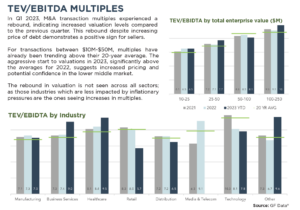Selling Your Business to an Existing ESOP is a Win-Win
While selling your business to a newly formed Employee Stock Ownership Plan (ESOP) is an intriguing and rewarding exit path, forming an ESOP can be complex and expensive, and is not appropriate for all businesses. But, what if you could sell your business to an existing ESOP company, allowing you to secure your financial future, secure the future success and legacy of your company, and benefit your employees? This is a real possibility for many business owners, including one of my recent clients.
Before delving into these two options, I want to point out that an Employee Stock Ownership Plan is a retirement plan that allows employees to become partial owners of the company. Instead of traditional retirement benefits like a 401(k), employees receive the benefit of shares of the company’s stock over time, typically at no cost to them.
Why consider an ESOP for your company?
1. Preserve Your Legacy
For an owner, one of the most significant advantages of selling to an ESOP is the ability to preserve the legacy of the business. Your employees, who are already familiar with your company’s culture and values, can carry on the traditions, values and vision you’ve built over the years. While selling to an existing ESOP company does not guarantee to maintain the cultural continuity of your company, there is evidence that ESOPs maintain more stable employment and survive recessions better than other companies. ESOPs provide the opportunity to create an enduring legacy for you and your employees.
2. Maintain a Motivated and Committed Workforce
Employees who become owners through an ESOP often become more engaged and motivated. They have a personal stake in the company’s success, which can lead to increased productivity and a stronger commitment to the business’s long-term success. Employees gain a valuable retirement benefit, fostering loyalty and attracting top talent to the business.
3. Enjoy Tax Benefits
There can be substantial tax advantages for both the business owner and the company when selling to an ESOP. Depending on the structure of the sale, the owner may be able to defer or even eliminate capital gains taxes on the sale of their company even if it’s to an existing ESOP company.
Form an ESOP or sell to an existing ESOP?
While selling to an ESOP can offer numerous benefits to an owner, forming an ESOP is expensive, time consuming and importantly requires having an experienced management team in the company able to administer it. Sometimes, selling your business to an existing ESOP company is a better strategy. Here are six compelling reasons to consider this option over forming a new own ESOP:
- Variety of buyer candidates: According to the National Center for Employee Ownership (NCEO) there are roughly 6500 ESOP companies covering a wide array of industry verticals from technical services to manufacturing, construction, wholesale trade and others. About 2% of these are ESOP holding companies which own a variety of companies. There is likely to be acquisitive ESOPs in your industry.
- Immediate Implementation: Creating an ESOP from scratch requires time and resources, including legal, financial, and administrative efforts. Selling to an existing ESOP allows you to skip this lengthy set-up process and immediately transition ownership to a well-established ESOP.
- Reduced Administrative Burden: Managing an ESOP involves ongoing administrative responsibilities, such as record-keeping, annual valuations, and compliance with regulatory requirements. Setting up an ESOP requires having management in place that can manage the administration. When you sell to an existing ESOP, these responsibilities are shouldered by the existing ESOP trustees and administrators, saving you time and effort.
- Experienced Management: Established ESOPs typically have experienced leadership in place, including trustees and administrators who understand the intricacies of ESOP operations. This can provide peace of mind and ensure a smoother transition for your employees.
- Easier Valuation Process: Determining the fair market value of your business can be complex and contentious. Selling to an existing ESOP often involves a more straightforward valuation process because the ESOP trustees are already well-versed in this aspect of managing an ESOP.
- Immediate Employee Buy-In: Employees that are working for a company that is being sold to an existing, functioning ESOP are more likely to be receptive to the transition and readily embrace the ESOP model, fostering a positive and motivated workforce from day one.
Selling your business to an existing ESOP can be a win-win scenario for many small business owners and their employees, especially those who lack the resources or infrastructure to form their own ESOP. The benefits include a quicker implementation process, reduced administrative burdens, a simplified valuation process, and immediate employee buy-in. These factors can make the transition smoother and more efficient, benefiting both you as the business owner and your employees.
We can help you to sell your business to an ESOP. If you’d like to have a confidential, no commitment discussion on your exit plans or have related questions, please contact Adam Wiskind, Senior M&A Advisor at (707) 781-8744 or awiskind@exitstrategiesgroup.com.







